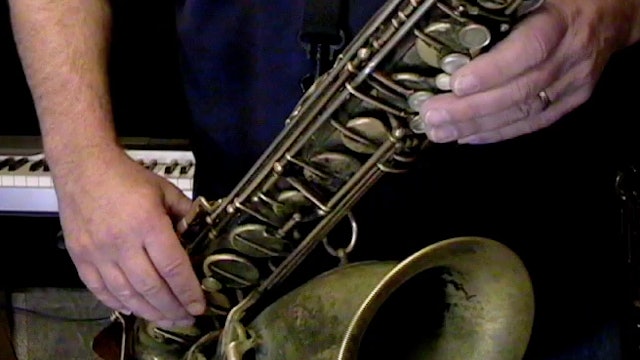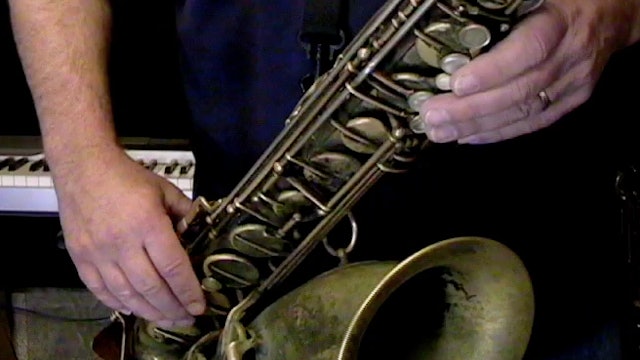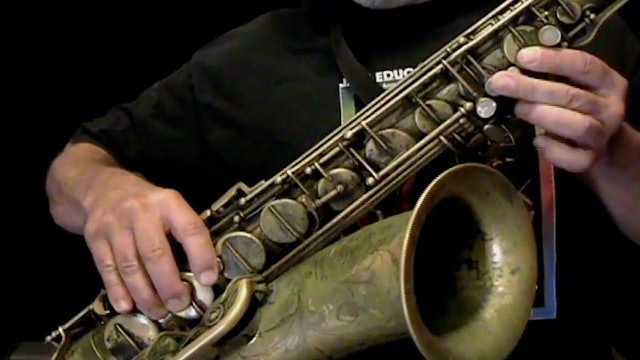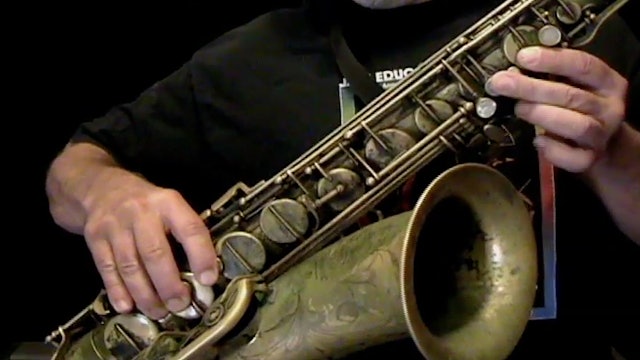Stage II Jazz Improvisation Lessons
For musicians with a bit of experience but still fairly new to improvising, these lessons would help you continue to build your skills, develop your improvisation vocabulary, learn more about jazz theory, and get a bit more soul in your playing.
Lesson topics include:
Jazz Sound & Style
Jazz Improvisation: How to Play Chord Changes
Sax Tips & Inflection
Shaping the Blues Scale (2-Lessons)
Relating the Pentatonics (learn about major and minor pentatonic scales and how to use them)
Major, Minor Dominant: What's the Difference?
Intervals: The Building Blocks of Jazz
The Foundation of Technique and Harmony
Metronome Obsession: Practicing in Time
-
Jazz Sound and Style
You may often wonder why, even though you're playing all the right notes, you still don't get quite the sound you're looking for when you play. In this lesson, you'll learn how to give your music that jazz sound and style. The exercises and examples are based on passages created over the chord ch...
-
Jazz Improvisation: How to Play Chord Changes
In this lesson, you'll take the first steps toward learning how to improvise over tunes with chord changes. In addition to learning how to interpret some of the most common types of chord symbols, you'll learn an easy-to-follow routine for practicing and assembling your musical vocabulary into me...
-
Shaping the Blues Scale, Part 1
This lesson offers an approach for practicing and using the blues scale. The exercises are designed to help you locate the most soulful sounds in the blues scale. Exercises and examples are based on the C and G blues scales, but are easily transposed to any key
-
Shaping the Blues Scale, Part 2
This lesson addresses the use of the blues scale in relation to the chords in the blues progression. By targeting specific tones on the different chords, an approach is outlined for creating sophisticated and soulful sounding phrases. Examples and exercises are based on the C blues scale, but are...
-
Relating the Pentatonics, Part 1
In this lesson, you'll learn the relationship between the major pentatonic, minor pentatonic, and blues scales. Exercises and examples are provided that will teach you how to determine, understand, and play these scales in any key.
-
Relating the Pentatonics, Part 2
In this lesson, you'll learn technique building patterns using pentatonic scales. We also practice improvising together using the B flat minor pentatonic scale. Exercises and examples are transposed for tenor and alto sax. Play-along track included in the Extras!
-
Major, Minor, Dominant: What's the Difference?
This lesson explores the differences between basic major, minor, and dominant chords and the arpeggios. Not just a theory lesson- a practice method is also outlined for learning to understand these types of chords, and for playing the arpeggios.
-
Intervals: The Building Blocks of Jazz
This lesson provides a practical guide to understanding the different simple intervals (intervals within one octave) and offers playing exercises for learning and internalizing them in all keys.
-
The Foundation of Technique and Harmony
In this lesson, you'll combine the study of jazz theory with practice designed to build your technique and an internalized knowledge of the foundation of jazz harmony. You'll begin by learning the naturally occurring chords found within a major key center. This is followed with patterns that will...
-
Metronome Obsession: Practicing in Time - Video 1
In this lesson, I'll show you some of my favorite practice techniques for breaking free of the intimidation and confusion often associated with the metronome, as we work to build your technique and internal sense of time, tempo, and rhythm.
-
Metronome Obsession: Practicing in Time - Video 2
Learn how to practice in time with some of my favorite metronome techniques. This is video 2 in the series.
-
Sax Tips 1 - The Growl
In this video, you'll learn to create the raspy, sometimes raunchy, growl often associated with rock playing. You'll also discover how it can be used to add a subtle texture to your jazz ballad solos.
-
Sax Tips - Growl OK_1
-
Sax Tips 2 - Basic Vibrato
In this video, I show you how to create basic vibrato using your lip. You'll also learn about the whys and whens of using vibrato in your playing.
-
Sax Tips 3 - The Scoop
Learn how to perform the scoop on your sax. This techniques is used to add soul to your passages.
-
Sax Tips 4 - The Down Bend
Learn the difference between Down Bends and Falls along with exercises for achieving this soulful technique.
-
Sax Tips 5 - The Glissando
Learn how to effectively combine "fall" type bends with scale tones, often chromatic, to create an effect that connects tones.
-
Sax Tips 6 - Falls
Learn how to create a fall on the saxophone in this technique that is similar to a glissando with no musical destination. It has the illusion of magically disappearing into nothingness.
-
Sax Tips 7 - Advanced Vibrato
Learn how to create vibrato using your tongue and throat in a manner that provides you with exceptional control of the sound.
-
Jazz Improvisation - How to Play Chord Changes.pdf
140 KB
-
Shaping the Blues Scale, Part 1.zip
149 KB
-
Shaping the Blues Scale, Part 2.zip
112 KB
-
Relating the Pentatonics, Part 1.pdf
61.6 KB





















